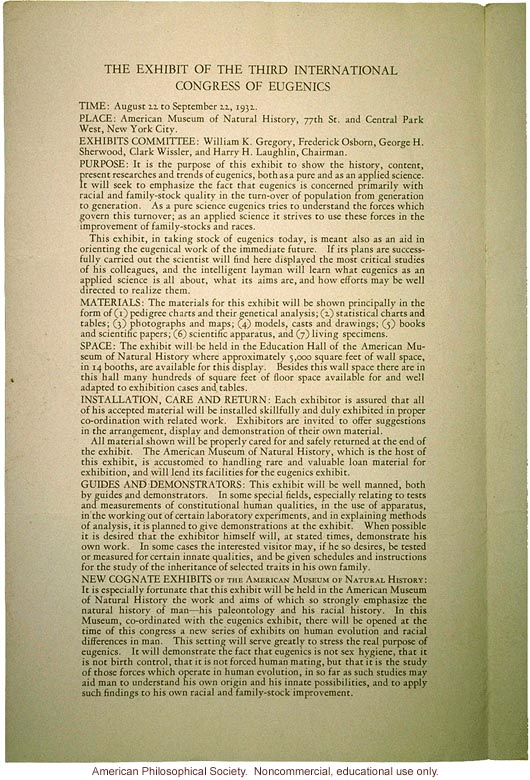The exhibit of the Third International Congress of Eugenics (1)

The exhibit of the Third International Congress of Eugenics (1)
489. The Exhibit of the Third International Congress of Eugenics. Time: August 22 to September 22, 1932. Place: American Museum of Natural History, 77th St. and Central Park West, New York City. Exhibits Committee: William K. Gregory, Frederick Osborn, George H. Sherwood, Clark Wissler, and Harry H. Laughlin, Chairman. Purpose: It is the purpose of this exhibit to show the history, content, present researches and trends of eugenics, both as a pure and as an applied science. It will seek to emphasize the fact that eugenics is concerned primarily with racial and family-stock quality in the turn-over of population from generation to generation. As a pure science eugenics tries to understand the forces which govern this turnover; as an applied science it strives to use these forces in the improvement of family-stocks and races. This exhibit, in taking stock of eugenics today, is meant also as an aid in orienting the eugenical work of the immediate future. If its plans are successfully carried out the scientist will find here displayed the most critical studies of his colleagues, and the intelligent layman will learn what eugenics as an applied science is all about, what its aims are, and how efforts may be well directed to realize them. Materials: The materials for this exhibit will be shown principally in the form of (1) pedigree charts and their genetical analysis; (2) statistical charts and tables; (3) photographs and maps; (4) models, cases, and drawings; (5) books and scientific papers; (6) scientific apparatus; and (7) living specimens. Space: The exhibit will be held in the Education Hall of the American Museum of Natural History where approximately 5,000 square feet of wall space, in 14 booths, are available for this display. Besides this wall space there are in this hall many hundreds of square feet of floor space available for and well adapted to exhibition cases and tables. Installation, care and return: Each exhibitor is assured that all of his accepted material will be installed skillfully and duly exhibited in proper co-ordinates with related work. Exhibitors are invited to offer suggestions in the arrangement, display and demonstrations of their own material. All material shown will be properly cared for and safely returned at the end of the exhibit. The American Museum of Natural History, which is the host of this exhibit, is accustomed to handling rare and valuable loan material for exhibition, and will lend its facilities for the eugenics exhibit. Guides and Demonstrators: This exhibit will be well manned, both by guides and demonstrators. In some special fields, especially relating to tests and measurements of constitutional human qualities, in the use of apparatus, in the working out of certain laboratory experiments, and in explaining methods of analysis, it is planned to give demonstrations at the exhibits. When possible it is desired that the exhibitor himself will, at stated times, demonstrate his own work. In some cases the interested visitor may, if he so desires, be tested or measured for certain innate qualities, and be given schedules and instructions for the study and inheritance of selected traits in his own family. New Cognate Exhibits of the American Museum of Natural History: It is especially fortunate that this exhibit will be held in the American Museum of Natural History the work and aims of which so strongly emphasize the natural history of man - his paleontology and his racial history. In this Museum, co-ordinated with the eugenics exhibit, there will be opened at the time of this congress a new series of exhibits on human evolution and racial differences in man. This setting will serve greatly to stress the real purpose of eugenics. It will demonstrate the fact that eugenics is not sex hygiene, that it is not birth control, that it is not forced human mating, but that it is the study of those forces which operate in human evolution, in so far as such studies may aid man to understand his own origin and his innate possibilities, and to apply such findings to his own racial and family-stock improvement.
- ID: 10483
- Source: DNALC.EA


